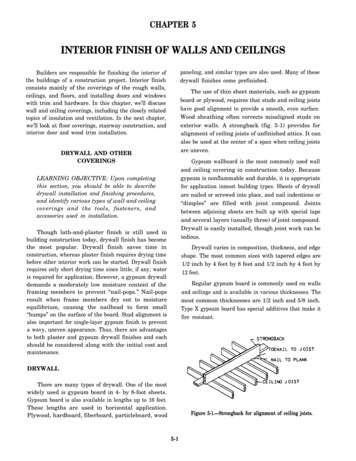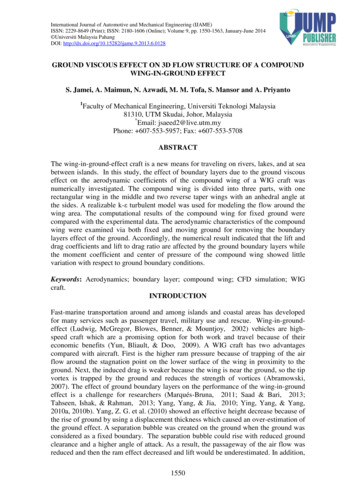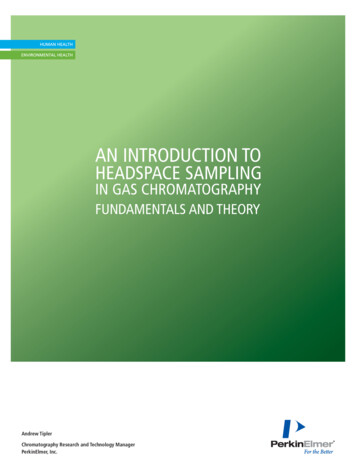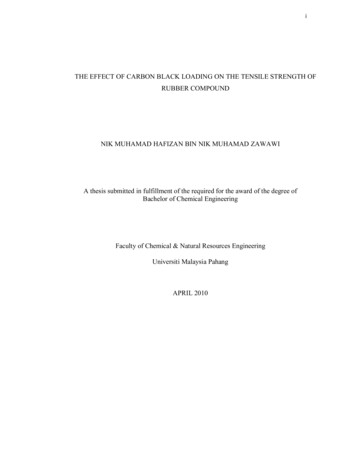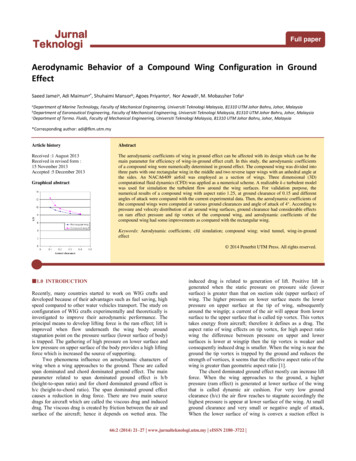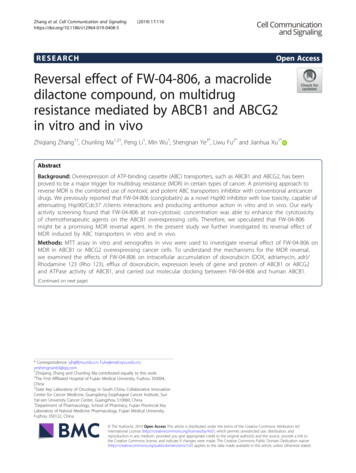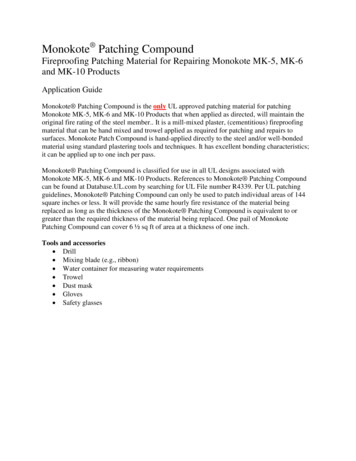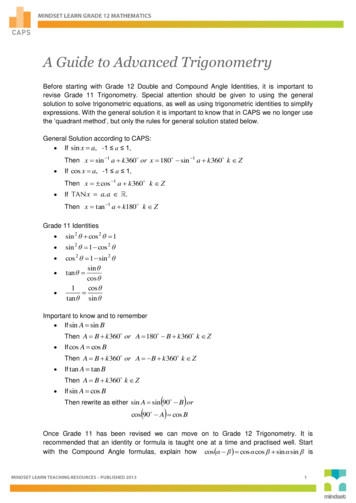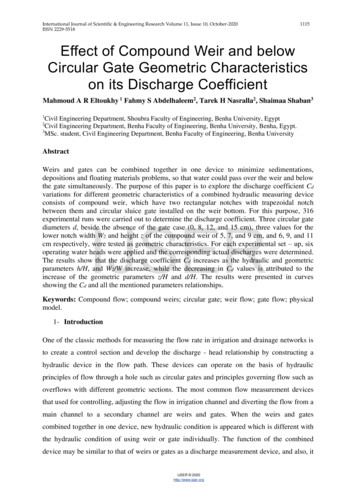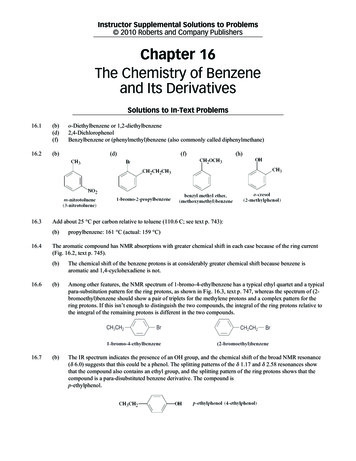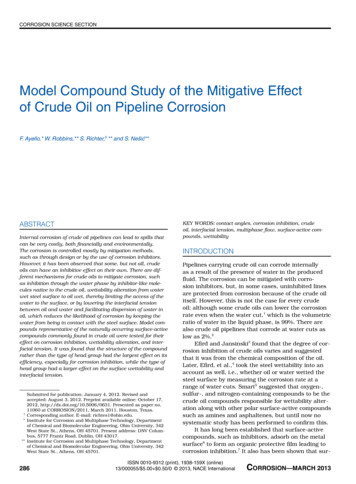
Transcription
CORROSION SCIENCE SECTIONModel Compound Study of the Mitigative Effectof Crude Oil on Pipeline CorrosionF. Ayello,* W. Robbins,** S. Richter,‡,** and S. Nes̆ić**AbstractInternal corrosion of crude oil pipelines can lead to spills thatcan be very costly, both financially and environmentally.The corrosion is controlled mostly by mitigation methods,such as through design or by the use of corrosion inhibitors.However, it has been observed that some, but not all, crudeoils can have an inhibitive effect on their own. There are different mechanisms for crude oils to mitigate corrosion, suchas inhibition through the water phase by inhibitor-like molecules native to the crude oil, wettability alteration from waterwet steel surface to oil wet, thereby limiting the access of thewater to the surface, or by lowering the interfacial tensionbetween oil and water and facilitating dispersion of water inoil, which reduces the likelihood of corrosion by keeping thewater from being in contact with the steel surface. Model compounds representative of the naturally occurring surface-activecompounds commonly found in crude oil were tested for theireffect on corrosion inhibition, wettability alteration, and interfacial tension. It was found that the structure of the compoundrather than the type of head group had the largest effect on itsefficiency, especially for corrosion inhibition, while the type ofhead group had a larger effect on the surface wettability andinterfacial tension.Submitted for publication: January 4, 2012. Revised andaccepted: August 3, 2012. Preprint available online: October 17,2012, http://dx.doi.org/10.5006/0631. Presented as paper no.11060 at CORROSION/2011, March 2011, Houston, Texas.‡Corresponding author. E-mail: richtes1@ohio.edu.* Institute for Corrosion and Multiphase Technology, Departmentof Chemical and Biomolecular Engineering, Ohio University, 342West State St., Athens, OH 45701. Present address: DNV Columbus, 5777 Frantz Road, Dublin, OH 43017.** Institute for Corrosion and Multiphase Technology, Departmentof Chemical and Biomolecular Engineering, Ohio University, 342West State St., Athens, OH 45701.286KEY WORDS: contact angles, corrosion inhibition, crudeoil, interfacial tension, multiphase flow, surface-active compounds, wettabilityIntroductionPipelines carrying crude oil can corrode internallyas a result of the presence of water in the producedfluid. The corrosion can be mitigated with corrosion inhibitors, but, in some cases, uninhibited linesare protected from corrosion because of the crude oilitself. However, this is not the case for every crudeoil; although some crude oils can lower the corrosionrate even when the water cut,1 which is the volumetricratio of water in the liquid phase, is 99%. There arealso crude oil pipelines that corrode at water cuts aslow as 2%.2Efird and Jansinski3 found that the degree of corrosion inhibition of crude oils varies and suggestedthat it was from the chemical composition of the oil.Later, Efird, et al.,4 took the steel wettability into anaccount as well, i.e., whether oil or water wetted thesteel surface by measuring the corrosion rate at arange of water cuts. Smart5 suggested that oxygen-,sulfur-, and nitrogen-containing compounds to be thecrude oil compounds responsible for wettability alteration along with other polar surface-active compoundssuch as amines and asphaltenes, but until now nosystematic study has been performed to confirm this.It has long been established that surface-activecompounds, such as inhibitors, adsorb on the metalsurface6 to form an organic protective film leading tocorrosion inhibition.7 It also has been shown that sur-ISSN 0010-9312 (print), 1938-159X (online)13/000055/ 5.00 0.50/0 2013, NACE InternationalCORROSION—MARCH 2013
CORROSION SCIENCE SECTIONface-active compounds can induce a wettability alteration (from water wet to oil wet) on iron carbonate8and pipeline steel9 substrates. By promoting wettability alteration from water wet to oil wet, crude oils canpromote protection from corrosion by hindering waterfrom coming into direct contact with the steel to initiate the corrosion process.Vera and Hernandez10 pointed out that oil-waterflow patterns can depend on the properties of thecrude oil. There are two dominant flow patterns inoil-water pipeline flow, stratified and dispersed. Foroil, continuous flow corrosion is more prevalent instratified flow since the water flows freely at the bottom of the pipe, while in dispersed flow the wateris entrained in the flowing oil phase. The transitionbetween stratified and dispersed flow depends onthe force balance between the turbulence in the flow,which acts to break up the water phase into smallerdroplets, and the interfacial tension, which opposesthe break-up process.11 The surface-active compounds can accumulate at the oil-water interface,lowering the oil-water interfacial tension12 and promote dispersion13 by facilitating the break-up process,and, in some cases, can even stabilize emulsion.14Efforts have been made to decipher which components from crude oils promote corrosion inhibition.The task is made more complicated by the fact thatcrude oils can differ substantially in their compositionor characterization. For instance, crude oils classifiedas paraffinic did not seem to contribute to the corrosion inhibition in the same way as asphaltenic crudeoils,15 although in both cases, resins, asphaltenes,and the presence of sulfur and nitrogen compoundswere implicated as being corrosion-inhibitive. A laterstudy identified nitrogen- and oxygen-containing compounds as inhibitive species capable of partitioningto the water phase.16 Stroe, et al.,17 found that mainlynitrogen-containing “inhibitor-like” compoundspassed from the oil to the water phase, and althoughincreased partitioning correlated with increased corrosion inhibition, it was not possible to relate the corrosion inhibition to the total nitrogen content of thecrude oil.A different approach than testing whole crudeoils is to select model compounds that are representative of crude oil compounds. Although this approachmakes use of a much simplified system compared totesting whole crudes, it provides information aboutthe contribution of specific groups of chemicals. Previously, the corrosion inhibition and wettability effectof asphaltenes was studied18 using this methodology;in this paper, results from other surface-active compounds are presented. Model compounds of surface†(1)(2)Trade name.UNS numbers are listed in Metals and Alloys in the Unified Numbering System, published by the Society of Automotive Engineers(SAE International) and cosponsored by ASTM International.American Petroleum Institute (API), 1220 L Street NW, Washington, DC 2000.CORROSION—Vol. 69, No. 3Table 1Elemental Composition of the Mild Steel (C1018)Sample Used as a Rotating Cylinder Electrode for theElectrochemical Corrosion aZrBTaTiFeWeight 150.0150.0130.010.0070.0040.0030.0020.0020.0002 0.001 0.001Balanceactive compounds were selected to represent oxygen-,sulfur-, and nitrogen-containing compounds, andthey were tested for corrosion inhibition, wettability,and dispersion of water in oil.Experimental proceduresMaterialsThe water phase was 1 wt% sodium chloride(NaCl) deionized (DI) water, purged with carbon dioxide (CO2) and adjusted to pH 5 for each test, and themodel oil phase was a clear paraffinic, light distillate (LVT200†). The steel used for corrosion tests wasC1018 (UNS G10180)(1) carbon steel with a chemicalcomposition outlined in Table 1, and the steel usedfor contact angle tests was API(2) 5L X65 carbon steel.As a result of the large number of chemical compounds found in crude oil, it is not possible to testevery single one of them. However, it is possible tochoose model compounds that represent differentclasses of surface-active compounds found in crudeoil: aromatics, and oxygen-, sulfur-, and nitrogen containing compounds. These classes are listed in Table2 along with their subclasses and the chemical compound chosen to represent each subclass.Aromatic compounds adsorb onto the steel surface by sharing π-electron density from the aromaticring with the metal surface.19 The aromatic chosen forthis study is 1,2,3,4-tetrahydronaphthalene, whichalso is used to dissolve the nitrogen-containing compounds in the model oil.287
CORROSION SCIENCE SECTIONTable 2List of the Surface-Active Compounds Used in the Present ResearchMolecularDescriptionChemical 132.2Short-chaincarboxylic acidAcetic ncarboxylic acidMyristic acidCH3(CH2)12COOH228.37Naphthenic acidMixture(CH2)n–R COOHR cyclopentane orcyclohexane, n 12SulfurcontainingcompoundsSaturated ringstructure 214ThiopheneDibenzothiopheneC12H8SSulfidesDioctyl encontainingcompounds184.26Carboxylic acids are the type of oxygen-containing compounds with the highest potential for adsorption in crude oil. They adsorb onto the steel surfaceby the interaction of electron density, as manifestedby unshared electron pairs on the oxygen within themolecule, with the metallic surface,20 blocking themetal’s active site and therefore decreasing the corrosion rate. However, not all carboxylic acids are protective and small-chain organic acids are known toincrease the corrosion rate,21 while long-chain organicacids, or naphthenic acids, can induce corrosion protection. Acetic acid (CH3COOH) was used as representative of small molecule organic acids, and myristicacid (CH3[CH2]12COOH) was chosen to represent longchain organic acids. The molecular formula used forthe naphthenic acids was R–(CH2)n–COOH, where Rrepresents saturated 5- and 6-membered ring structures, n 1 to 2, and total C# is 1. In this study, acommercially available mixture of naphthenic acidsextracted from diesel distilling cut was tested. Mass288spectrometry study of the mixture suggests that 1 to3 ring structures are prevalent for the naphthenicacid molecules.22Sulfur-containing compounds can adsorb in ananalogous fashion as oxygen-containing compoundsusing unshared electrons. Sulfur-containing compounds are subdivided into two categories: non-polar(sulfide, thiophenes) and polar forms (thiols commonly known as mercaptans).23 The thiols are morereactive than sulfides because of their polarity andactive hydrogen. In sulfur heterocycles (such as thethiophenes), the sulfur atom has only one bond toabsorb at the metal surface. Therefore, sulfur heterocycles are less surface-active than sulfides. Dioctylsulfide, dibenzothiophene, and tetradecanethiol weretested to represent sulfides, thiophenes, and mercaptans, respectively (Table 2).Nitrogen-containing compounds adsorb in ananalogous fashion as both oxygen- and sulfur-containing compounds. They are subdivided into two cat-CORROSION—MARCH 2013
CORROSION SCIENCE SECTION(a)(b)Figure 1. (a) Image of the goniometer used for the measurements, including a stainless steel vessel, a camera, and abacklight. (b) A polytetrafluoroethylene (PTFE) holder sits inside the vessel of the goniometer and serves to hold the carbonsteel sample, which is used as a substrate for the contact angle measurement.24egories: pyridinic forms (known as basic nitrogen),which accounts for about a third of the nitrogen compounds found in the crude oil, and pyrrolic forms(known as neutral nitrogen), which accounts for twothirds of the nitrogen compounds.23 Acridine was originally chosen to represent pyridinic compounds andcarbazole to represent pyrrolic compounds (Table 2).Additional pyridinic compounds were tested after thepreliminary results for acridine showed exceptionalcorrosion inhibition; these were benzo(h)quinoline,benzo(c)quinoline, and phenanthroline.Corrosion MeasurementsA 2 L glass cell apparatus mounted with a rotating cylinder electrode (RCE), with a surface area of5.3 cm2, was used for the corrosion measurements.The experimental setup has been described in detailin a previous publication18 and consists of a threeelectrode system, including a 15 mm diameter carbonsteel rotating cylinder working electrode, a silver/silver chloride (Ag/AgCl) reference electrode, and a platinum counter electrode.At the beginning of each test, 1.8 L of the waterphase (1 wt% NaCl in DI water purged with 1 barCO2 and adjusted to pH 5.0) with deareated sodiumbicarbonate (NaHCO3) was prepared, and the C1018carbon steel working electrode with the chemical composition listed in Table 1 was polished with 400 gritand 600 grit sandpaper and cleaned with acetone(CH3COCH3) and isopropanol (C3H8O) in an ultrasonic bath. During testing, the working electrode wasrotated (2,000 rpm) in the glass cell.The surface-active compounds (Table 2) wereintroduced in the glass cell by adding them to 200 mLof the model oil, which was placed on top of the waterphase. The concentration of the compounds is measured in weight percentages, where 0.1 wt% equalsCORROSION—Vol. 69, No. 31,000 ppm concentration, to be in a similar range ofconcentration as commonly found in the native crudeoil. The exception is the acetic acid, which was dissolved in the water phase, and the nitrogen-containing compounds, which were dissolved in a 40%tetrahydronaphthalene-model oil mixture. The rotating working electrode was moved subsequently upinto the oil phase for 20 min to allow for the adsorption of the surface-active compounds on the metalsurface after which the working electrode was moveddown into the water phase and the corrosion rate wasmeasured every 5 min using linear polarization resistance (LPR). Baseline tests were conducted by exposing the working electrode to the pure model oil phaseas well as the 40% tetrahydronaphthalene-model oilmixture.The corrosion inhibition (CI [%]) is calculatedusing the inhibited (CRinh [mm/y]) and the uninhibited(CRuninh [mm/y]) corrosion rates with the following formula:CI (CRuninh – CRinh)/CRuninh 100(1)Contact Angle MeasurementsThe contact angle measurements were conductedin a goniometer such as shown in Figure 1(a).24 Thesetup includes a stainless steel vessel with windowson either side. A back light lights up the inside ofthe vessel through a glass window protruding fromeach side of the vessel allowing the camera to recordthe evolution of the droplet with time. The vessel ismounted on an adjustable slider to allow for optimaldistance for the video camera to capture the image ofthe droplet. There is a polytetrafluoroethylene (PTFE)holder positioned inside the vessel of the goniometer and the steel sample is mounted on top of theholder (Figure 1[b]). It is possible to measure either289
CORROSION SCIENCE SECTION(a)(b)FIguRe 2. Example of a water-in-oil contact angle of (a) hydrophilic (low contact angle) and (b) hydrophobic (high contactangle) surface.FIguRe 3. Geometric correlation needed to calculate the contactangle. The image shows the oil-in-water configuration of the droplet.the water-in-oil contact angle of a water droplet surrounded by the oil phase (Figure 2) or an oil-in-watercontact angle of an oil droplet surrounded by thewater phase. This has been described in detail in aprevious publication.18For a water-in-oil contact angle measurement,the substrate is hydrophilic (Figure 2[a]) if a droplet ofwater is able to spread out and forms a contact angleless than 90 . The substrate is hydrophobic (Figure 2[b]) if a water droplet has little or no tendencyto spread out and forms a contact angle greater than90 . The contact angle is always measured from thewater phase.The current work was done using water-in-oilcontact angles. The preparation of the oil and the waterphase was as follows: 1% by weight of surface-activecompound was added to 1 L of model oil. The oilphase (model oil, 800 mL) and water phase (1% NaCl,pH 5, 1 bar CO2, 200 mL) were mixed in a beaker for1 h, then left to settle overnight to equilibrate. A flatcarbon steel (X65) sample was cleaned with acetoneand polished sequentially with 400 grit and 600 grit290sandpaper, then further cleaned with isopropanol inan ultrasonic bath for 2 min. The sample was thendried and immersed in the vessel of the goniometer,which previously had been filled with model oil andpurged with CO2. A droplet of water then was addedon the top of the sample (Figure 1[b]), and the evolution of the droplet at the metal surface was recordedfor 2 h. Baseline tests were conducted by using a puremodel oil as well as a 40% tetrahydronaphthalenemodel oil mixture.The contact angle, θ, was calculated using Equation (2) using an imaging analysis software to measure L and R, with R being the radius of the dropletand L the length of the wetted area as shown in Figure 3. Since only the ratio of L and R is important, theunit of measurement is pixels: L θ 180 – arcsin 2R (2)Interfacial Tension MeasurementsThe interfacial oil-water tension was measuredwith a tensiometer using the Du Noüy ring methodwith a platinum ring. The preparation of the liquidsolutions was the same as outlined for the contactangle measurements. The glassware and the platinumring were rinsed with acetone and isopropanol. Theglassware was dried in air while the platinum ringwas heated with a flame (holding the ring ca. 1 cmfrom the flame). The pre-partitioned water phase waspoured into the glassware, and the oil phase wascarefully poured on top of the water phase. The platinum ring was inserted into the water phase after theoil phase had been placed on top. This helped withthe reproducibility of the results without changing theresults compared to placing the platinum ring in thewater phase before pouring the oil phase on top. Thering was pulled up through the oil-water interface andCORROSION—MARCH 2013
CORROSION SCIENCE SECTIONthe tension [mN/m] at which the interface broke wasread of the dial on the tensiometer.Results and DiscussionCorrosion Inhibition MeasurementsIn this study, carboxylic acids represent the oxygen-containing compounds found in crude oil. Whilethe addition of short-chain acetic acid increased thecorrosion rate when added to the water phase (Table3), the exposure of the steel to the long-chain myristic acid or naphthenic acids dissolved in the oil phasepromoted inhibition (Figure 4).The baseline values are recorded in a separatetest, where the carbon steel working electrode isexposed to the pure model oil phase, before the corrosion rate (Figure 4) is measured in the water phase,producing an average baseline corrosion rate of0.84 mm/y. This baseline is comparable to the baseline corrosion rate without exposure to model oil,which was recorded at 0.83 mm/y (Table 3). Therefore, it is possible to conclude that the model oil hasno effect on the corrosion rate.The corrosion inhibition of both long-chain myristic acid and naphthenic acid is around 40% at 0.1 wt%concentration as can be seen in Figure 4 and isshown with white markers, but at 1 wt% concentration (black markers) the corrosion inhibition of myristic acid surpassed that of the naphthenic acids, andis 87% compared to 72% for the naphthenic acids.The concentration of naphthenic acids needs to beincreased to 10% to produce comparable corrosioninhibition to the myristic acid.Figure 5 shows the results obtained with thesulfur-containing compounds dibenzothiophene, dioctyl sulfide, and 1-tetradecanethiol for concentrationsof 0.1 wt% (shown with white markers) and 1 wt%(shown with black markers). At 0.1 wt% concentration(100 ppm), dibenzothiophene and dioctyl-sulfide arenot significantly different from the baseline corrosion.Even at 1 wt% (1,000 ppm) concentration the corrosion inhibition is less than 20%. However, with theaddition of 1-tetradecanethiol (a mercaptan), the corrosion rate decreases significantly. Even at 0.1 wt%concentration, 1-tetradecanethiol produces a 40%corrosion inhibition; at 1 wt% concentration, the corrosion inhibition is 82%.The baseline for the nitrogen-containing compounds is measured after exposure to 40 wt% tetrahydronaphthalene, which is an aromatic used todissolve both carbazole and acridine in the modeloil. The average baseline corrosion rate of the aromatic and model oil mixture is 0.80 mm/y, which iscomparable to the 0.84 mm/y baseline after exposure to pure model oil (Figures 4 and 5), showing thatthe aromatic (tetrahydronaphthalene) has no effecton corrosion. For 0.01 wt% (100 ppm) and 0.1 wt%(1,000 ppm) concentrations of carbazole, there is noCORROSION—Vol. 69, No. 3table 3Corrosion Rate for Acetic Acid Added to the Water Phase(0.1 wt% 1,000 ppm)Acetic Acid (wt%)Corrosion Rate (mm/y)00.0010.010.10.830.901.172.21Figure 4. Corrosion rate measured with LPR after the steel surfacehas been exposed to oxygen-containing compounds representativeof different forms of carboxylic acids dissolved in model oil.Figure 5. Corrosion rate measured with LPR after the steel surfacehas been exposed to sulfur-containing compounds representative ofthiophenes, sulfides, and mercaptans dissolved in model oil.corrosion inhibition (Figure 6), while for acridine,there is 80% corrosion inhibition at only 0.01 wt%concentration and more than 99% corrosion inhibition at 0.1 wt% concentration, in which case the LPRpolarization resistance, PR, is 40 kΩ.It is questionable whether the impressive corrosion inhibition obtained with acridine is a characteristic of all pyridinic compounds. Therefore, otherpyridinic compounds, namely, benzo(h)quinoline,benzo(c)quinoline, and phenanthroline (Table 2), were291
CORROSION SCIENCE SECTIONFigure 6. Corrosion rate measured with LPR after the steel surfacehas been exposed to nitrogen-containing compounds representativeof pyrrolic and pyridinic compounds dissolved in model oil mixed withan aromatic.quinoline had no corrosion inhibitive behavior, whilebenzo(c)quinoline and phenanthroline had a modestcorrosion inhibition of 50%. The effect of the acridineis therefore more of a steric effect caused by the structure of the acridine compound, allowing the moleculesto line up so that the nitrogen atom is adsorbed onthe surface, while the aromatic rings align with a π–πbonding between them, in which water molecules cannot penetrate.Looking at individual compounds is very informative, but crude oils are a complex mixture of thousands of chemicals. It is possible to have a positiveor negative synergy between two or more compoundsso that the overall corrosion inhibition is more or lessthan the corrosion inhibition of the individual compounds. Furthermore, surface-active compounds canbe acidic or basic, and it is possible these compoundscould be neutralized, which could compromise theirsurface activity.To test the synergistic corrosion inhibition of anacid and a base, a varying concentration of myristicacid is tested against a constant concentration of acridine (Table 4). The myristic acid does have a negativesynergistic effect on the corrosion inhibition of acridine; but, although the corrosion rate has more thanquadrupled with a tenfold concentration of myristicacid compared with acridine, the corrosion rate is stillin the range of micrometers per year.Contact Angle MeasurementsFigure 7. Corrosion rate measured with LPR after the steel surfacehas been exposed to additional pyridinic compounds dissolved inmodel oil mixed with an aromatic.table 4Synergistic Corrosion Rate for Acridine and Myristic nResistance,PR (Ω)0.116,2000.111,4000.1 3,560CorrosionRate(mm/y)1.7 10–32.5 10–37.9 10–3tested as well. The chemical composition of the quinolines is the same as for acridine, but the chemicalstructure is slightly different. The chemical structureof phenanthroline differs from that of the benzo(h)quinoline by an additional nitrogen atom replacing aCH group on an aromatic ring structure.The additional pyridinic compounds were testedat 0.01 wt%, 0.1 wt%, and 1 wt% concentrationsand the results are given in Figure 7. The benzo(h)292When a water-in-oil contact angle measurementis performed, the water droplet is deposited on topof the steel surface. As can be seen in Figure 8, thewater droplet wets the surface and spreads out slowlyuntil equilibrium is obtained at 58 in this case ofpure model oil.The result of the baseline test shown in Figure 8is displayed in Figures 9 and 10 along with the resultsof the water-in-oil contact angles measured for different surface-active compounds added to the oil phase.Figure 9 shows the contact angles measured after5 min of exposure, while Figure 10 shows the contact angle after a 2 h exposure. Contact angles lessthan 90 indicate a hydrophilic surface, while contactangles greater than 90 indicate a hydrophobic surface.For the aromatic compound (tetrahydronaphthalene) the contact angle water-steel remained at180 for more than 30 s before it started to decrease,reaching 130 after 5 min and a stable value of 60 inless than 2 h, the surface turning from hydrophobicto hydrophilic in the process. The final contact angleof the aromatic is very similar to the one obtainedwith the model oil on its own, but the time needed toreach the final value is much longer. The aromaticityof tetrohydronaphthalene provides stronger adsorption than possible with only the paraffinic model oil.The straight-chained paraffinic hydrocarbons are onlyCORROSION—MARCH 2013
CORROSION SCIENCE SECTIONt 1st 30 st 180 st 600 sFigure 8. The contact angle of a water droplet in model oil (water-in-oil) at different times (1, 30, 180, and 600 s) showingthe spreading of the droplet over a span of 5 min.Figure 9. Water-in-oil contact angle for different model compoundsadded to the model oil, with the exceptions of acridine and carbazoleadded to a mixture of model oil and tetrahydronaphthalene andacetic acid added to the water phase, after 5 min of exposure. Allconcentrations are in weight percent.Figure 10. Water-in-oil contact angle for different model compoundsadded to the model oil, with the exceptions of acridine and carbazoleadded to a mixture of model oil and tetrahydronaphthalene andacetic acid added to the water phase, after 120 min of exposure. Allconcentrations are in weight percent.capable of forming weak van der Waals bonds to thesurface, which are not as strong as the π-bondingpossible with the aromatic ring structure. However,the π-bonding is not sufficiently strong to keep thesurface hydrophobic, and the water phase slowlyspreads on the steel surface, displacing the hydrocarbons and making the surface hydrophilic in the process. Because of the length of time it takes for thewater to spread on the surface, it can be concludedthat in a intermittent oil-water flow when the steel’ssurface is alternatively wetted with oil and water,aromatic compounds can play a protective role. Thisprotection would be lost in the case of stagnant orstratified flow, since the water eventually would displace the aromatic compounds in the oil.While acetic acid, representing the small-chaincarboxylic acids, does not have an effect on steel wettability, the long-chain carboxylic acid (myristic acid)CORROSION—Vol. 69, No. 3293
CORROSION SCIENCE SECTIONInterfacial Tension MeasurementsFigure 11. Oil-water interfacial tension with the different compoundsadded to the oil phase with the exceptions of acridine and carbazoleadded to a mixture of model oil and tetrahydronaphthalene andacetic acid added to the water phase.and the cyclic carboxylic acids (naphthenic acids)had a very strong effect on the wettability of the steel,changing the contact angle from 58 to 180 , producing a completely hydrophobic surface. Even after 2 hof exposure, the water droplet never wetted the steelsurface.The effect of sulfur-containing compounds onsurface wettability is less than the effect of the longchain and cyclic carboxylic acids. Dibenzothiophene, which contains a cyclic ring structure just asthe naphthenic acids, has no effect on the wettability of the steel, pointing to the importance of the carboxyl end group on the surface activity. The dioctylsulfide, which has a sulfur atom with saturated aliphatic chains on either side, does raise the contactangle at a 1 wt% concentration, but this compounddoes not change the wettability of the steel surface from hydrophilic to hydrophobic. In the case ofboth the thiophene and sulfide compounds, the sulfur atom on its own is not able to form a strong bondwith the surface. Tetradecanethiol, representing thethiols containing an active –SH group, is more efficient to adhere to the surface than the thiophene andthe sulfide and changes the contact angle from 58 to95 , making the surface slightly hydrophobic. However, comparing the wettability alteration of the tetradecanethiol to the one of myristic acid, which is alsoa C14 organic acid, it can be seen that the –SH endgroup adsorbs weaker on the steel surface than thecarboxylic end group.There was no effect of the nitrogen-containingcompounds on the surface wettability detected. Measurements of the contact angle for acridine and carbazole mimicked the behavior of the aromatic (tetrahydronaphthalene), which was used to dissolve them.294One factor of minimizing the likelihood of corrosion is to minimize the contact between the waterphase and the pipeline steel surface. In an oil-waterflow, the dispersion of water in the oil phase is facilitated by a lower interfacial tension. Therefore, adecrease in the interfacial tension would promote corrosion protection. By looking at Figure 11, it can beseen that the effect of the tested surface-active compounds on the interfacial tension is limited. The aromatic compound (tetrahydronaphthalene) has noeffect on the interf
effect on corrosion inhibition, wettability alteration, and inter-facial tension. It was found that the structure of the compound rather than the type of head group had the largest effect on its efficiency, especially for corrosion inhibition, while the type of head group had a larger effect on the surface wettability and interfacial tension.


